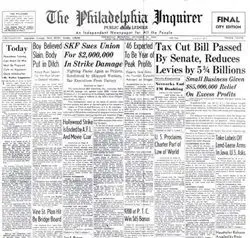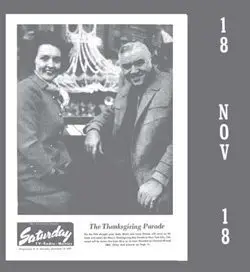One Man. One Machine. 26 Million+ Newspaper Images

Photo credit: Old Fulton New York Post Cards
Client
Old Fulton New York Post Cards
Project:
Digitization of a vast array of historic newspapers preserved on microfilm dating from 1726 for free online access
Statistics:
26 million newspaper pages and growing
Solution:
Purchase of archive-quality production microfilm scanners with automated batch scanning and OCR technology for bitonal and grayscale images
Equipment:
- Wicks and Wilson 8850 Scanstation
- Wicks and Wilson RS325 Scanstation
- Wicks and Wilson 4001 Scanstation
A retired manufacturing engineer, Tom Tryniski devotes his time to digitizing historical newspaper from microfilm using a Wicks and Wilson Scanstation production-level microfilm scanner. This may be a one-man operation, but in the past 15 years, he has scanned an astonishing 26 million+ pages of newspaper. He hosts the images to his website, Old Fulton New York Post Cards. The sole creator, sponsor and project manager for this operation, Tryniski manages the website out of his home in the small town of Fulton, NY. Tryniski explains, “It started out as a hobby but has morphed into a major website for information that cannot be found elsewhere.”
Getting Started
Tryniski retired from a career that spanned manufacturing and computer systems at the young age of 49. His first website featured a collection of historic Fulton post cards dating from 1870, which were loaned to him by a friend. Soon after, he scanned a local newspaper dating from 1947, the Oswego Valley News, by hand on a flatbed scanner.
The original newspapers, larger than the area of the tabloid-sized scanner, required him to scan different sections at a time to get a full-page image, making the process slow and labor-intensive. Increasing interest in his site, coupled with his desire to make more titles available, led Tryniski to scan the newspaper images from microfilm.
“The feedback from people who were using my site was much more than I ever expected,” Tryniski recalls of this first digitization project. “Visitors said they found papers or articles on the site which they had been searching years for, or never expected to find, with just a simple keyword search. At that point, I purchased my first Wicks and Wilson Scanstation and contacted libraries about lending microfilm to add to my site.”
Scanners Mandated by Material and Volume
Tryniski’s initial purchase decision involved research and comparison. He recalls, “I attended an industry conference and was able to see all the scanning equipment vendors in one place. I asked a lot of questions and brought microfilm with me for sample image comparison. I wanted to see how each scanner handled less-than-perfect positive service copies, which is the type of microfilm I work with.” A service copy is a duplicate of the print master, which loses image quality compared to the print master. Tryniski’s requirements for high volume capacity, automation, affordability and image quality led him to purchase a Wicks and Wilson 4001 Scanstation in 2003. This allowed him to produce bitonal images from 16 and 35mm microfilm in fragile or decaying conditions.
After four years and four million images digitized with the 4001, Tryniski wanted to scan faster and in grayscale. He upgraded to the Wicks and Wilson RS325 Scanstation. Seven million images later, heavy volume dictated a third upgrade and Tryniski chose the brand that had served him well in the past, selecting a Wicks and Wilson 8850 productionlevel microfilm scanner with enhanced image quality of up to 600 dpi and speeds of up to 330 frames per minute. The 8850 also offered Tryniski a 12-bit camera system, intuitive image location and real-time onscreen viewing of the microfilm while he scanned. He has digitized approximately 15 million images with the 8850 to date and the scanner continues to operate smoothly. “My Wicks and Wilsons have, or still do, run without any maintenance cost or repair,” says Tryniski. “They just keep running.”
The Source Material
Tryniski’s newspaper microfilm rolls are sourced mainly from libraries and historical societies. “The people who use my site will ask for specific publications,” notes Tryniski. “I contact the library or organization with the microfilm and request permission to borrow. I also am contacted by libraries asking if I will scan their collection.” In exchange for loaning Tryniski the microfilm service copies and granting permission to post the images, the institutions are given a copy of the scanned images for their own use. Often, Tryniski will travel many miles to collect the film personally to reduce the risk of damage during shipping.
“My Wicks and Wilsons have, or still do, run without any maintenance cost or repair. The just keep running.”~ Tom Tryniski, Old Fulton New York Post Cards

The Conversion Process
Tryniski spends an average of 70-80 hours a week scanning microfilm, using batch-scanning technology to speed through an entire roll with imaging parameters automatically set from a sample section of film. After processing and OCR treatment, the original 300 dpi PDFs are saved to high-capacity hard drives for off-site storage; duplicate copies are saved on a backup server. The files are then compressed to 150 dpi grayscale JPEG2000 images; this allows for a smaller file size that is more easily accessible online. The whole operation is managed using two Windows 2012 R2 servers with 12 PCs running text recognition software around the clock. Tryniski updates the website with new, text-searchable files almost every day.
The Result
The unconventional website features a spider-like “web crawler”with an image of Tryniski’s head attached and a comprehensivesearch tool. Viewers include any and all seekers of historical and genealogical documents. Almost half of the site visitors are from the United States; the remainder are from countries across the world including Australia, Turkey, Brazil and France.
Tryniski’s website has garnered attention over the years, including a Reason.tv feature.* Producer Jim Epstein praises Tryniski for his ability to produce such high volumes of free historic content while many government-funded projects require grants and expensive manpower and labor hours to do the same.
The site has quickly become one of the largest online historic newspaper collections in the world. In October of 2008, the site had a 31-day record of 124,194 visitors. Five years later, the 31-day record had jumped to over 1.5 million visitors. The project continues to operate under the sole management of Tom Tryniski. It is self-funded with the exception of donations from satisfied users. Upon completion or cessation of the project, Tryniski plans to donate a copy of the database to Archive.org and another copy to The New York State Library.
As of this print, Old Fulton New York Post Cards hosts digitized issues from 500+ New York newspapers as well as newspapers from North Carolina, Kentucky, Pennsylvania and even a few Canadian provinces.
1. http://reason.com/blog/2013/03/05/amateur-beats-govt-at-digitizing-newspap
About The Crowley Company
Incorporated in 1981, The Crowley Company is a leading digital and analog film technologies company headquartered in Frederick, Md. with manufacturing divisions (Mekel Technologies, Wicks and Wilson, Extek and HF Processor brands) in California and the United Kingdom. With over 100 employees, The Crowley Company provides an extensive number of digital document and film conversion services to the publishing, commercial, government and archive sectors and also manufactures, sells, and services high-speed microfilm, microfiche and aperture card scanners, microfilm duplicators, film processors and micrographics equipment.
Contact us for more information
